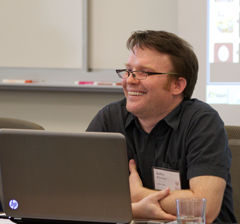teaching methods
Select an item by clicking its checkbox

The Other Side of Pedagogy: Lacan's Four Discourses and the Development of the Student Writer
Date Reviewed: May 15, 2015
Readers of T.R. Johnson’s ambitious The Other Side of Pedagogy: Lacan’s Four Discourses and the Development of the Student Writer will find some unexpected juxtapositions: Ouija boards and zombies side by side with Hannah Arendt and Keith Richards, student writers jostling with hysterics and narcissists. From this amalgam of unlikely characters, Johnson’s more conventional thesis emerges: contemporary education lacks a sense of its goals, other than a vague notion that student development means initiating students into a loosely-defined ideal of the academy. Johnson suggests that we can rescue ourselves and our students from this stagnation by recognizing what has been there all along: the pulsing unconscious, the unbidden and ultimately irrepressible system of desire that we all carry around with us but like to pretend we do not. This evocation of the unknowable and uncanny is what mobilizes Johnson’s playful evocation of high and low culture.
Johnson posits a model of student development based on Lacan’s famous lecture series of the late 1960s. Student writers, Johnson argues, move through four stages, as articulated by Lacan in his theory of the four main types of discourse. In the first two stages, the discourses of mastery and of the University, students are passive receptacles of teacherly authority, their unconscious ideally repressed and their prose, when they can write at all, “empty mimicry” (133).
The last two discourses are where things get really interesting. The third discourse is that of the hysteric, whose appearance is “a singularly disruptive performance . . . wreaking havoc with the conventional, lockstep procedure of the bureaucracy, as when Marlon Brando’s character in The Wild One, when asked what he is rebelling against, responds ‘Whaddya got?’” (195). Here, Johnson offers a useful reframing of the problem student, the eye-roller, the note-passer, the interrupter. Instead of understanding these students as impediments to classroom coherence, Johnson casts them as paradoxically more advanced than the good student who always has the right answer. These disruptive students are engaging the unconscious when they exceed and unsettle the roles prepared for them, the social assumptions about who and what they ought to be. However, like Keith Richards writing “I Can’t Get No Satisfaction” in his sleep, the hysteric cannot control his or her discourse, but rather “stumble[s] in a narcotic dream from one summit to the next” (188).
The final discourse is that of the analyst, a discourse marked by humility, openness, and equality. To explain this discourse, Johnson imagines a class in which students and teacher listen carefully to one another and thus arrive at unexpected and unplanned places, a class in which students write papers that put multiple texts in conversation with one another to see what emerges. These students and teachers harness the unconscious to the extent that they are engaged in dialogue with the other. If we seek to sustain these productive engagements, we must realize that “the aim of our courses is ultimately to teach our students to love – specifically, to love working and playing with words and texts and ideas, and, through these, to love each other, the wider world, and the ideal of justice, more and more and more” (207). These are inspiring words, and perhaps the most evocative explanation I’ve ever heard of why pedagogical practices like service learning and community engagement – which court unexpected moments of empathy and, ideally, writing and thinking that resonate beyond the self and the stale loop of teacher-oriented writing – are so critical to breathing life into our institutions.
One of Johnson’s most powerful contributions in this book is his insistence on seeing students and teachers as complex, embodied people who bring the fullness of their selves and their unconscious desires with them into the classroom. Throughout, I found myself recognizing myself and my students, and recognizing myself in my students. Johnson’s appeal to our fullest personhood allows him to think of pedagogy as a way of understanding people interacting with people, ideas with ideas, and not as a goal-oriented assessment task.
Yet, while Johnson’s unpacking of Lacan’s four discourses is illuminating, the way he frames them as a linear developmental schema – something, he acknowledges, Lacan never intended – is at odds with the more associative, recursive nature of the unconscious itself. That is, for a book that delights in the juxtaposition of high and low culture, its structural principles are over determined, as if Johnson is trying to contain the very unconscious he is unleashing.
Finally, Johnson’s book fits squarely into a recent trend in composition studies: the urge to retell the history of the field to highlight a neglected thread that, when exposed, could reinvigorate our teaching. Indeed, Johnson spends the first half of the book detailing an exhaustive history of psychoanalysis’s second-class status in the history of writing pedagogy. Byron Hawk’s A Counter History of Composition (2007) and Donna Strickland’s The Managerial Unconscious in the History of Composition Studies (2011) are two examples of recent books that do something similar, turning to psychoanalytic theories of desire and repression to get at what is unknowable, almost magical, about both the activities of writing and of teaching. Johnson’s text is an imaginative and welcome, if sometimes unwieldy, addition to this new canon of writing pedagogy.

The Plugged-In Professor: Tips and Techniques For Teaching With Social Media
Date Reviewed: February 26, 2015
This volume is designed more like a handbook than a piece of prose. Aside from the preface that details how the volume is arranged and how each successive chapter is outlined, each chapter (twenty-five in total) represents a stand-alone essay that describes how an instructor can integrate a piece of social media into her or his curriculum and assignment portfolio. The essays are divided into four parts. The essays in Part 1, “Research, Writing and Information Fluency,” focus on applications of social media that challenge students to develop effective research and writing skills. The essays on “sharing” sites are of note because they offer instructors insight on how to use social media sites that students are already using to share research through bookmarking cultural artifacts.
Part 2, “Communication and Collaboration,” is divided into two sections. The first section focuses on instructional communication through social media. Each social media outlet examined in this section is a communicative tool (for example, Wimba or YouTube) that can be re-allocated for educational purposes. The second section of Part 2 concerns issues of collaboration in terms of students working together on educational projects through social media tools such as Google Docs, study blogs, and group-designed wikis.
Part 3, “Critical Thinking and Creativity,” is also divided into two sections. The first section considers how students can demonstrate critical (and, I might add, culturally perceptive) thinking through social media outlets such as Tumblr and Facebook. Students are challenged in these sections to examine social trends and personal expressions offered by users of these social media outlets to ascertain how persons learn and demonstrate social ethics or personal and professional development. The second section focuses on creative final course projects such as digital storytelling or video streaming presentations.
Part 4, which concludes the volume, focuses on integrative learning, on integrating research, communication, collaboration, critical thinking, and creativity into one social media project. The final essay is of note here because it describes how students conducted a “social media campaign” through Twitter (xxvii). The students researched a client, communicated with opinion leaders in the client’s field, and promoted the client’s cause through critical reflection and creative engagement.
The Plugged-In Professor clearly articulates that learning can be promoted in a host of ways through the use of social media. Therefore this is a valuable resource. The social media savvy instructor will be able to wade through the technical language with ease and find projects that he or she can use in class. However, the digital immigrant or digital alien may be overwhelmed at first. This volume can be read straight through, but one is likely to get bogged down in the various approaches and creative projects. It may be more helpful to read this volume like a tasting menu, sampling this Twitter-based exercise or that exercise for Google Docs. Perhaps it could be seen in a similar light as the Teaching Theology & Religion “Teaching Tactics.” Regardless of how one reads the material, the instructor should be careful to assess each project’s usefulness before implementing a social media project. The only real limitation to this volume is that the field of religious studies and theology was not represented, but religion and theology faculty can adapt these projects for their courses. For example, I was challenged by some of the essays in Part 1 to develop a wiki group project for my Pentateuch course. That said, it would be have useful and encouraging to see at least one sample of how social media has been used in a religious studies or theology course.
The previous post identified three possibilities for using Twitter in class. It is only fair that I also explore three pitfalls for using Twitter to lecture less while teaching more 1. Twitter does not allow for nuance. The main concern I hear about Twitter—from both professors and students—is that ...
Time was, my Biblical Hebrew students and I sweated grimly in a thrice-weekly race against time. But now, with the lectures recorded (as voice-narrated Keynote/PowerPoint presentations) and moved outside of the classroom as homework, Biblical Hebrew has become the least predictable three hours of our week…because we have ...
My unpleasant memories of middle school English classes are made much worse when I recall how some teachers taught poetry and prose by picking “important” passages and pontificating about them. Learning to “read” poetry was essentially learning to listen to a lifeless lecture. When I first began teaching I too ...


